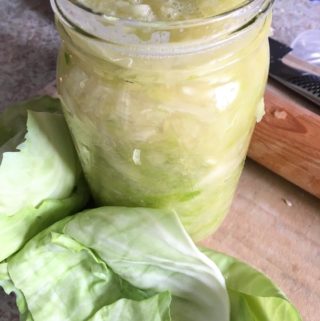
Homemade Sauerkraut
This nutrient-dense and probiotic-rich sauerkraut is ridiculously easy to make, and so tasty, too!
Equipment
- Wide mouth mason jar
- Kraut pounder or flat-edged rolling pin
- Baking sheet
- Large mixing bowl
- Knife, mandoline, or food processor
- Weight (ziplock baggie filled with water or small water-filled jar)
Ingredients
- 1 2lb head of cabbage
- 1 tbsp Celtic sea salt (start with a tsp)
Instructions
- Peel the outer layers of the cabbage. Rinse the leaves and the cabbage and reserve the leaves.
- Cut the cabbage in half, remove the core, quarter, and shred using a knife, mandoline or food processor.
- Place the shredded cabbage in a large mixing bowl and sprinkle on 1 tsp of salt.
- Massage the cabbage for 10-15 minutes until a brine forms at the bottom of the bowl. When you squeeze a handful of cabbage, it should drip.
- Transfer the cabbage to the jar in stages, pressing down on it to remove air pockets and to submerge it in brine.
- Using the reserved leaves, fold them up and tuck them into the jar, securing them under the shoulder. Place a weight over top and cover loosely with a lid. Place on a baking sheet to catch any overflow.
- Allow the sauerkraut to ferment for 5-7 days. Check it daily and remove the lid to release any gas. Give it a daily taste test and move to the refrigerator when satisfied with its taste and texture.
Notes
- The longer the sauerkraut ferments, the softer and more acidic it gets.
- During fermentation, always ensure the sauerkraut is covered in brine. Remember: if it's covered in brine, everything's fine.
- If a brine doesn't form, try resting the cabbage for a little bit, letting the salt do the work for you, or add a bit more salt.
- It's easier to add more salt than to remove it. If it tastes good raw, it's going to make a delicious kraut!
